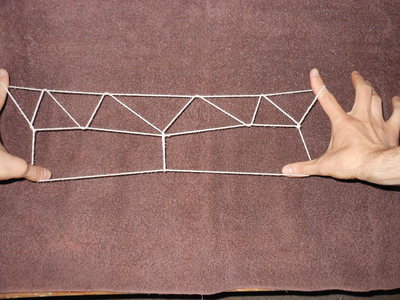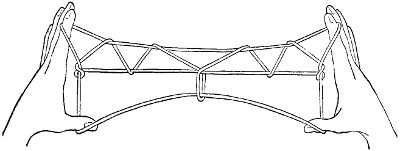

LLX > Neil Parker > String Figures > Jayne


1. Position 1.
2. Pass indexes down in front of near thumb string, and then turn them away and up, picking up the near thumb string.
3. Pass right thumb under string that goes from left thumb to left index finger, and return.
4. Pass left thumb from above into upper right thumb loop, and pick up from below the lower right near thumb string (that goes to the right index), and return through the upper right thumb loop.
5. Pass right little finger under right index loop, and into upper right thumb loop from above, and hook down far upper right thumb string. At the same time pass left little finger into left index loop from above, and hook down far left index string.
6. Release thumbs, but do not pull the strings tight. From this point until the figure is done, it's best to keep the strings loose.
7. Pass right thumb under right little finger loop, and up into right index loop from below. Turn right thumb away, down, toward you under little finger loop, and up, carrying right far index string on its back.
8. At the same time, pass left thumb under left far little finger string, and up into the loop that hooks around the left little-finger-index-finger string from below. Turn left thumb away, down, toward you under far little finger string, and back up, carrying the far string of this loop on its back.
9. Transfer thumb loops to indexes, and let new index loops slip down below original index loops.
10. Transfer upper (original) index loops to thumbs, release index loops, and transfer thumb loops back to indexes.
11. A small vertical loop encircles each little finger loop, near the little finger. Pointing thumbs away from each other, insert them into these loops, and return carring the far strings of the loops.
12. Insert indexes into thumb loops from above, pick up near thumb strings, and return. Release thumb loops, and let new index loops slip down below original index loops.
13. Repeat step 10.
14. Pass thumbs away from you over far little finger strings and under all other strings, closer to the middle of the figure than the loops that encircle the little finger loops at each end. Release little fingers.
A careful inspection shows that the string crossings in this figure don't match the string crossings in Jayne's illustration. Jayne's illustration is wrong - the illustrated string crossings clearly wouldn't be stable.
In other sources ([Mary-Rousselière 1969], [Patterson 1949]), this figure is usually called "The Lamp."
LLX > Neil Parker > String Figures > Jayne